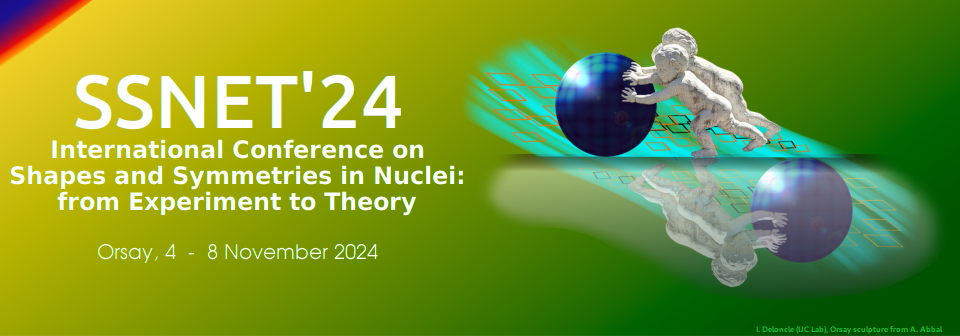Orateur
Description
With the construction and operation of next-generation large-scale radioactive nuclear beam facilities worldwide, numerous novel phenomena have been discovered through the excitation and decay of unstable exotic atomic nuclei, such as shape coexistence, shape phase transitions, octupole deformation, and more. These findings have brought about a fresh understanding of nuclear physics and posed significant challenges to traditional nuclear theories. To this end, we have developed a collective Hamiltonian model based on covariant density functional theory (CDFT), and conducted a series of research works in the field of nuclear shapes and collective motions.
(1) Using a five-dimensional collective Hamiltonian model based on CDFT, we have systematically explored even-even nuclear masses, quadrupole deformations, low-lying spectra, and more. We have reproduced the known regions of shape coexistence and predicted new coexistence regions [1]. Following this, we established a triaxial-and-pairing collective Hamiltonian that describes the triaxial shape vibrations, rotations, and coupling with pairing vibration. The coupling between triaxial shapes and pairing degrees of freedom, and its impact on the low-energy spectra, transition rates, and shape coexistence have been analyzed [2-4].
(2) Using a quadrupole-octupole collective Hamiltonian model and a microscopic core-quasiparticle coupling model based on CDFT, we have performed a comprehensive study on the octupole deformation and low-energy negative parity bands in the actinide region, including both even-even and odd-A nuclei. The theoretical calculations reproduce the experimental data well and yield configurations of parity doublets [5,6]. New parity doublets based on excitation states are also predicted. Furthermore, we have also incorporated the non-axial octupole deformation in the microscopic collective Hamiltonian framework and take 152Sm as an example to do an illustrative calculation [7].
Reference
[1] Y. L.Yang, P. W. Zhao, and Z. P. Li, Shape and multiple shape coexistence of nuclei within covariant density functional theory. Phys. Rev. C, 107, 024308 (2023).
[2] J. Xiang, Z. P. Li, T. Nikšić, D. Vretenar, and W. H. Long, Coupling of shape and pairing vibrations in a collective Hamiltonian based on nuclear energy density functionals. Phys. Rev. C, 101, 064301(2020).
[3] J. Xiang, Z. P. Li, T. Nikšić, D. Vretenar, W. H. Long, and X. Y. Wu. Coupling of shape and pairing vibrations in a collective Hamiltonian based on nuclear energy density functionals. II. Low-energy excitation spectra of triaxial nuclei. Phys. Rev. C, 109, 044319(2024).
[4] J. Xiang, Z. P. Li, et. al., The impact of pairing vibration on nuclear shape coexistence. In preparation.
[5] W. Sun, S. Quan, Z. P. Li, J. Zhao, T. Nikšić, and D. Vretenar, Microscopic core-quasiparticle coupling model for spectroscopy of odd-mass nuclei with octupole correlations. Phys. Rev. C, 100, 044319(2019).
[6] R. N. Mao, X. Zhao, Z. P. Li, et.al., Systematic study of parity doublets in radiums and actinides within the microscopic core-quasiparticle coupling model. In preparation.
[7] J. Xiang, J. Zhao, Z. P. Li, et.al., Triaxial quadrupole-octupole collective Hamiltonian based on covariant density functional theory. In preparation.

